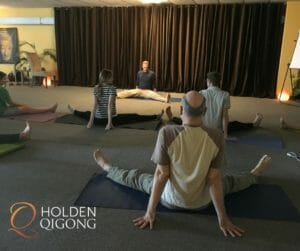The Qi Gong saying, “Flowing water doesn’t get stagnant,” directly applies to the health of your spine. In daily life, many people don’t get enough healthy movement. We sit at work, for meals, driving, and watching TV. This creates stagnant or blocked energy in the back. For example, nobody sits on a 5-hour plane flight and walks off saying, “I feel so good and rested.” This blog post will address how social and cultural conditions in the west often lead to stagnation, stiffness, and stress within the spine, as well as discuss how specific Qi Gong practices can help to relieve these issues and restore fluidity and strength.
Movement is key to a healthy body. Life moves. Look at anything in nature from a river flowing down the mountain to a tree in the wind. Movement circulates Qi, the life-force energy. The felt sense of stagnant energy is tightness, discomfort, and pain. If your neck, low back, or area between your shoulder blades gets tight, there are certain Qi Qong practices that can open the energy in these areas to help you live pain-free.
 If, in daily life, you engage your body in a variety of movements, postures, and exercises, you will feel more alive. In Qi Gong, each movement calls upon our internal energy (qi) to flow to various parts of our bodies. There is an emphasis on the energy pathways (meridians), which is the foundation of Chinese Medicine. When the energy pathways are clear the body stays healthy and free of pain. Of the energy pathways that run throughout our body, none is more important than that which runs throughout our spine. In Qi Gong, the energy flowing through the spine is referred to as the “Governing Channel” and is responsible for the fluid communication between all parts of the human body.
If, in daily life, you engage your body in a variety of movements, postures, and exercises, you will feel more alive. In Qi Gong, each movement calls upon our internal energy (qi) to flow to various parts of our bodies. There is an emphasis on the energy pathways (meridians), which is the foundation of Chinese Medicine. When the energy pathways are clear the body stays healthy and free of pain. Of the energy pathways that run throughout our body, none is more important than that which runs throughout our spine. In Qi Gong, the energy flowing through the spine is referred to as the “Governing Channel” and is responsible for the fluid communication between all parts of the human body.
In a physical sense, it is the structural foundation in everything that we do. From walking to exercise, from sitting to running, the spine is essential to all of life’s activities. Not only is the spine the foundation for the movement of the body, but it is also the superhighway of communication between mind and body. Your brain and nervous system conduct energy and information to every cell in your body and are more powerful than the best computer.
Given the significant role that the spine plays in all of life’s activities, it’s important to continually cultivate a strong, supple spine to support health and vitality in all parts of the body.
(Article continues below)
Our Physical Body: Cultivating Flexibility and Fluidity in our Spine and Joints
We all appreciate the care-free enthusiasm of a child playing in the dirt or rolling around on the ground. Children occupy their world fully, moving around as they please and not concerning themselves about whether they’re using the correct posture as they reach down to pick something off of the ground. Their youthful joints and spine have a natural flexibility and suppleness that hasn’t yet become inhibited by stress, poor posture, or the process of aging.
As humans age, there is a multitude of personal and environmental elements that tend to wear on the body, decreasing the suppleness and flexibility of all of our joints. For example, most adults spend several hours every day sitting at a desk or in a car, despite significant studies that clearly show the adverse effects of the western sitting position. Poor posture and a lack of varied movement further compound spine and joint issues, and the simple process of walking upright brings its own problems that are inescapable. With these culminating factors all contributing to back and spine issues, it’s no surprise that 65 million Americans experience back pain at any given time.
There are several lifestyle choices that can help your spine and joints — sitting less, exercising more, focusing on good posture — but there is one activity that focuses on all of the important elements that contribute to a healthy spine: Qi Gong. With the right intention and practice, the meditative movements of Qi Gong can dramatically help to release lines of tension and lubricate the joints and vertebrates. Bringing consciousness back to each movement and posture is very powerful not only for the Qi Gong practice itself, but because it helps cultivate greater full-body awareness, which naturally translates into better posture and healthier choices in our day to day life. By practicing Qi Gong movements that reduce spinal tension, increase flexibility, and clear stagnant energy, practitioners can reduce pain and increase physical vitality in their spines.
(Article continues below)

If you’d like to learn more about Qi Gong for a healthy, pain-free spine, check out our pre-recorded workshop, Qi Gong for a Healthy Spine.
The Governing Channel: Reducing Anxiety and Finding Emotional Balance
Just as our spine is a highway of communication for all movement and action in the external world, it also represents a central pathway for all emotional activity in our internal worlds. Qi Gong is based on the understanding that mind, heart, and body are all closely connected and dependant upon one another, and the spine truly is the “Governing Channel” that brings all parts together. When our muscles are relaxed, joints well lubricated, and nerves at ease, our emotions and feelings can flow easily throughout our body and we can be present with whatever is true for us in our internal worlds. By letting thoughts and feelings flow freely we can more easily face and accept where we are at both mentally and physically, as well as allow negative energies to freely transform into those that can serve us.
Similar to the process of opening up lines of tension to experience relief from physical ailments, the process of removing emotional blockages in our spines gives freedom to all parts of our beings, allowing all emotions to flow and manifest in the most healthy way possible. Without an open, fluid channel running throughout our bodies, emotions become stuck and stagnant, hindering happiness and causing feelings of anxiety. We all are familiar with the phrase “bottled up emotions,” and in Qi Gong, this idea correlates directly to the experience of stagnation and lack of fluidity.
Qi Gong for a Healthy Spine
As any Qi Gong practitioner knows, there’s something very powerful about integrating meditation and movement. Anyone who chooses to practice Qi Gong is aware on some level that the mind, heart, and body are intimately related, and each depends closely on the other for the well-being of the whole. In the case of the spine, it is a pathway for feeling, thought, and all physicality that takes place within the body, and Qi Gong focuses on spinal health is proactively cultivating all parts of the being. A Qi Gong movement that increases the spine’s flexibility also helps to increase the flow of thought and feeling throughout the body. Similarly, a strong visualization practice can create emotional clarity and energize the nervous system… leaving you calm and relaxed as you go throughout your day.
At Holden QiGong, we’re offering a pre-recorded workshop called Qi Gong for Healthy Spine. In this workshop, all of Lee’s lessons are dedicated to empowering students with tools and practices to continue cultivating a healthy spine for many years to come. This workshop is geared towards anyone who is seeking more ways to manage stress and anxiety, those who would like relief from physical pain or discomfort in their spine, and those who would like to focus on proactive measures to maintain their good health. Our bodies are rich with innate wisdom and qi flowing throughout, and giving some love to our Governing Channel is one of the best ways to ensure a healthy circulation of qi and a vital life force in our entire bodies.
To learn more about Qi Gong for Healthy Spine workshop, click here.
Also, below you’ll find a short sitting Qi Gong practice video to help you keep your spine healthy when you’re sitting for long periods of time. Enjoy!
Click here for Lee’s Qi Gong for Healthy Spine Workshop.
